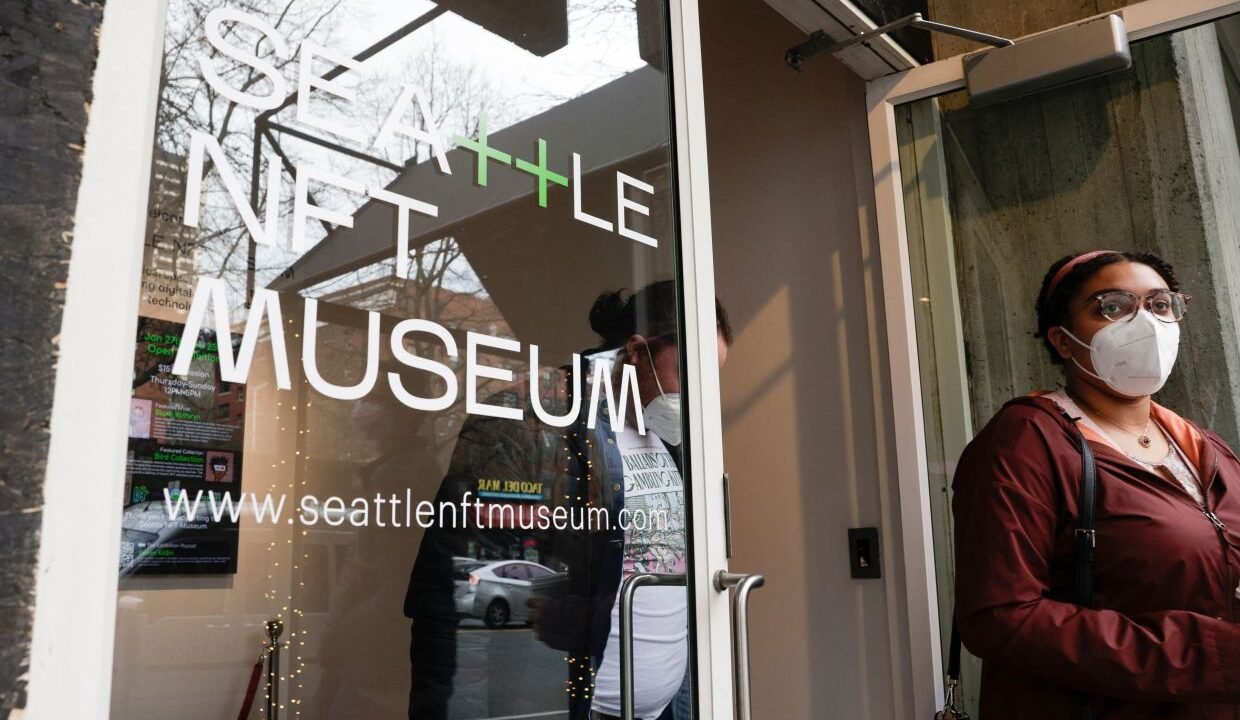
Like the volatile, hype-prone digital art market it briefly celebrated, the Seattle NFT Museum sometimes struggled to be taken seriously.
Billed as the world’s first museum for NFTs, or non-fungible tokens,” it opened in Seattle in 2022, when the NFT market was on fire and celebrities were paying fortunes for art that lived on cryptocurrency blockchains.
When the Belltown museum quietly closed its doors last December, on the heels of the global NFT market crash, some saw a fitting bit of real-world symbolism.
“Shocking,” quipped a typical online commenter. “Literally no one saw this coming.”
The snarky obituaries may be premature.
The NFT market is down but not out. Artists, including some in Seattle, say the technology is still bringing new audiences – and revenues.
The NFT Museum itself is doubling down. Its tech-industry founders say the closure is only temporary as they look for new, larger digs for the venue’s dozens of TV monitors and other gear.
“There’s still a lot of interest,” says co-founder Jennifer Wong. “A lot of the artists we showcased at the museum, especially locally, are still producing pieces today.”
Whether that actually results in a new NFT Museum is hardly certain. Wong and co-founder and husband Peter Hamilton don’t have a reopening date. And these aren’t easy times for art museums of any stripe.
But unpredictably has been a hallmark of the NFT space since 2014, when a Seattle-born digital artist named Kevin McCoy “minted” the first NFT as a way to protect ownership of digital artworks.
Until then, digital art’s copyable nature made it hard for creators to prove ownership or make sales.
McCoy’s idea, developed with technologist Anil Dash, was to link digital art to the same online ledger, or blockchain, used to verify and record individual cryptocurrency transactions.
Using that process, a creator could turn any digital content into a one-of-a-kind, or “non-fungible,” asset, whose authorship could be proved and, critically, whose ownership could be sold and tracked.
McCoy, a graduate of Bothell High School and Whitman College, later described NFTs as “hippie meets tech libertarian.”
Through the late 2010s, an NFT art market spurred a growing trade in everything from high-end art to collectors “cards” like Bored Apes.
Global NFT sales hit US$82mil (RM340mil) in 2020. A year later, they were at nearly US$20bil (RM83bil).
McCoy, now an artist in New York City, said he knew NFTs had commercial potential. “But seeing it actually happen – you’re just, like, ‘Oh, my God.’ “
Wong and Hamilton decided to open a museum after visiting several NFT galleries. They thought a physical space could make the virtual, esoteric art forms more accessible to a wider public.
They leased a ground-floor retail space in the Continental Place Condominiums, on Seattle’s First Avenue, and put up 30 wall monitors as well as educational displays of NFT history and technology. Admission was US$15 (RM62), later changed to a suggested donation.
The museum opened in January 2022, with the first of what would be a dozen exhibitions.
Reviews were mixed. Some visitors found the art derivative and the space sterile. “If I wanted to look at a bunch of TVs I’d go to Best Buy,” quipped one Yelp reviewer in April 2022.
Others criticised the substantial energy needed to “mint” NFTs. There was a small protest when the museum opened and a window was broken, but the issue faded after Ethereum, the main NFT blockchain, adopted a lower-energy process in late 2022.
Among local artists, some felt NFTs were a cryptocurrency scam and that tech component meant “that it wasn’t real art,” recalls Amy Tipton, owner of Slip art gallery and founder of Belltown Art Walk.
But the museum had plenty of fans. Openings were often crowded affairs, with artists, techies and students. The museum was also a big draw for tourists, including some would-be haters.
“I decided to go to the Seattle NFT Museum specifically to laugh at how ridiculous it is, and I walked out absolutely blown away by how fun and interesting it was,” said an out-of-town tourist in a 2022 online review.
The museum also had a following among digital artists, and even some traditional artists.
Seattle “grunge” photographer Charles Peterson, whose work appeared at the museum’s first show, found NFT technology “overwhelming,” and doesn’t think art like his worked on the museum’s screens.
But he couldn’t ignore the new audience NFTs unearthed for his black-and-white images of famous Seattle bands. An NFT of his image of Kurt Cobain lying on a drum set brought US$15,000 (RM62,160).
“It was not bad money,” recalls Peterson, adding that NFT sales made up a “pretty major” share of his sales.
Peterson wasn’t alone. Unlike in the traditional art market, NFTs can be set up to let artists earn money whenever their work is resold. And because sales were in cryptocurrency, artists prospered as crypto prices soared.
“We finally can make a really good living off of what we’re doing and have a lot of respect,” Bellevue illustrator Robbie Trevino, whose work appeared at the NFT Museum, told The Seattle Times in 2022.
Although the NFT Museum didn’t sell any art, Wong and Hamilton were mindful of the market’s energy and direction.
As Hamilton told KING 5 News, “We’re showing it for education, but certainly, we have works that are US$500,000 (RM2mil) in value up to US$1 (million/RM4.14mil) or even US$2mil (RM8.3mil) in value.”
Within months of the museum’s launch, however, there were signs that the party was over.
On NFT trading platforms, “snipers” were using bots to buy and flip promising tokens.
Maks Surguy, a Seattle tech worker and digital artist also featured at the museum, recalls making US$5,000 (RM20,720) on an NFT “in a matter of five minutes or so … because the bots were fighting for it.”
The NFT market was also getting saturated with knockoffs and bad art.
“There literally were factories … just spinning up (NFT) collections, every single day and just seeing what sticks,” said Art Min, a Seattle tech industry veteran who co-founded Phosphene, an NFT platform focused on Seattle-area artists.
In some cases, Min said, creators sold fraudulent NFTs, with made-up features, before vanishing with the funds – a scam known as a “rug pull.”
By May 2022, the NFT market was in free fall, as scams and a crash in crypto prices led collectors to dump their NFTs.
“I was seeing a lot of artists getting discouraged,” recalled Joana Kawahara Lino, who worked as curator at the NFT Museum.
After the crash, neighbours said the place often seemed empty during the week.
Wong says the museum wasn’t affected by the market drop. It continued to pull in visitors and was breaking even on costs, though that required donations and side gigs, including renting the space for events and for luggage storage for tourists.
The latter, done via an app, sometimes meant lines of “tourists, very forlorn, with luggage, standing in front of the doors,” said Continental Place concierge James Brock. He says noise from events was also an issue.
Wong said “the main reason” for closing was that the lease was up and the museum needed more room. Despite NFT’s crash and sketchy history, she thinks public interest remains for a brick-and-mortar venue, ideally downtown.
Fans of the museum hope she’s right. They note the NFT market has modestly recovered somewhat – around US$4bil (RM16.6bil) in sales this year – in part because crypto has rebounded.
Peterson, the photographer, says he’s considering new NFTs of some of his lesser-known work – “something like Seaweed at the Odd Fellows Hall.”
But proponents aren’t sure that means the world wants or will pay for an NFT museum.
Much of the NFT market has shifted toward more commercial uses, such as using tokens for loyalty programs, or as access to gaming.
Although NFTs succeeded in legitimising and monetising digital art, the concept itself may now be less compelling as a stand-alone art form, said McCoy, the NFT inventor. “NFTs have kind of returned to their native form of digital art, he said.
And, as practical matter, any arts venture is a gamble these days, as even established institutions like the Bellevue Arts Museum fail and many galleries see more of their sales move online.
That paradox – an in-person space for a virtual form – may be the NFT Museum’s biggest hurdle.
“It just seems weird there was a physical location for that,” said Erik Flatten, who owns the Black Cat Bar across First Avenue from the condo building.
Flatten isn’t complaining. He loved the extra business when museum events ended and NFT enthusiasts piled into his bar. He also gives Wong and Hamilton kudos for attempting such an unlikely venture.
“It was open a lot longer than I thought it would be.” – The Seattle Times/Tribune News Service











